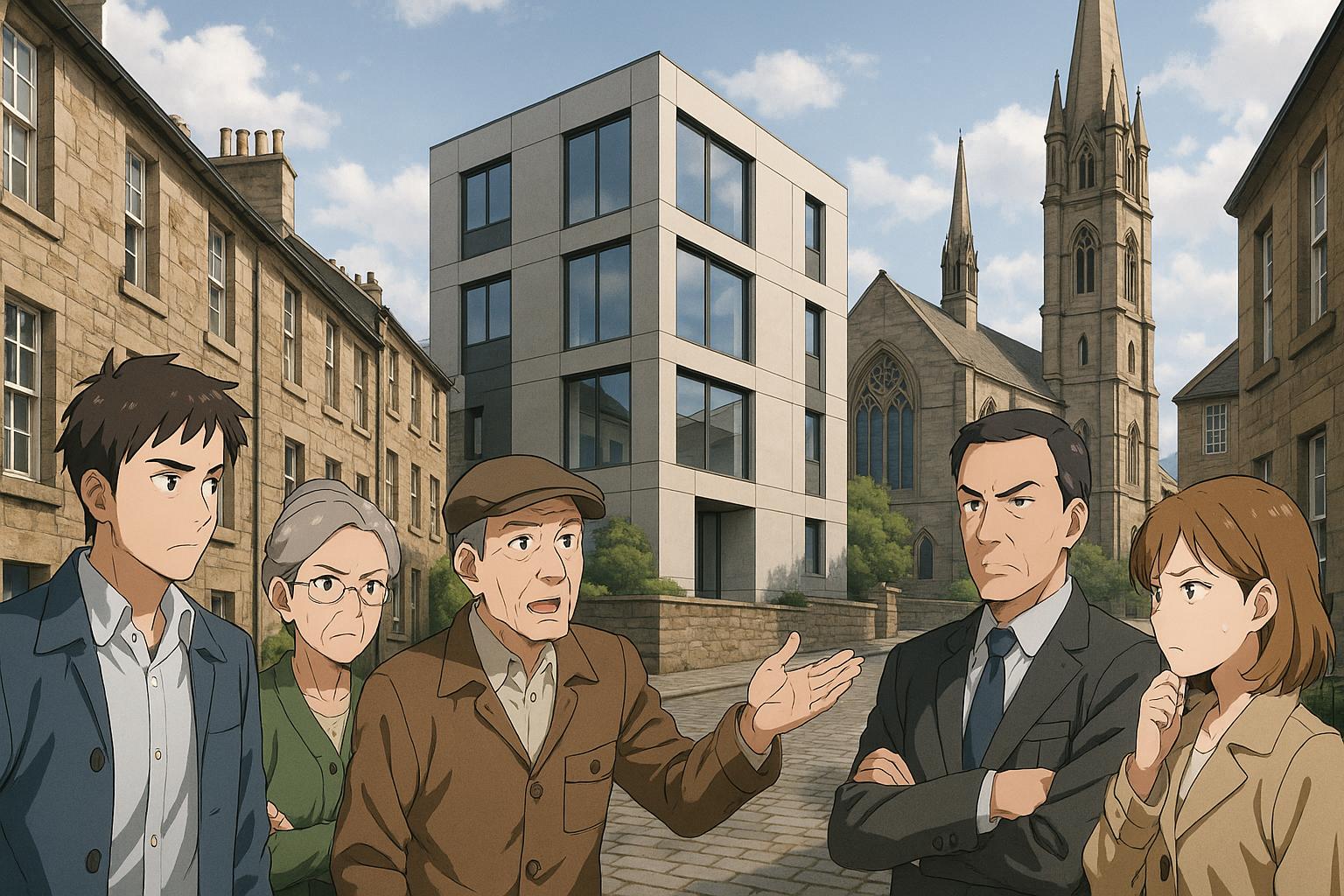Edinburgh’s planning appeals committee has controversially approved a five-bedroom home at 12 Blenheim Place despite community objections and potential impacts on the New Town Conservation Area and World Heritage Site status. The decision, made by a tied vote with the chair’s casting vote, has sparked claims of procedural failures and bias from local groups.
Last month, Edinburgh’s planning appeals committee made a contentious decision, overturning an earlier refusal by planning officers regarding the construction of a contemporary five-bedroom home at 12 Blenheim Place, adjacent to Greenside Church. The plot, characterised by developers as “disused” and lacking any significant landscaping features, has come under scrutiny from local community stakeholders who dispute this characterization. They emphasise that the area was historically a wooded space, home to mature trees and a dense undergrowth, which was largely removed following the 2017 felling of several key trees.
Local councillor Tim Jones, chairing the Local Review Body (LRB) meeting on April 2, praised the design of the proposed building as “very discreet” and “very well thought out”. He expressed that concerns over the potential obstruction of views of Calton Hill were being overstated. In a deadlock decision falling to a 2-2 split among councillors, Jones exercised his casting vote to grant approval.
However, this decision has drawn significant ire from the New Town and Broughton Community Council (NTBCC), which contends that the process was marred by “serious procedural failures” and apparent bias. They argue that the LRB’s discussion failed to adequately consider the implications for both the New Town Conservation Area and the prestigious World Heritage Site status, which the area holds due to its historical significance. The council’s handling of public input was also called into question, with NTBCC claiming that objections from four local organisations and 28 residents were disregarded during the decision-making process.
The NTBCC’s chairman, Peter Williamson, made clear his discontent, stating that the conduct during the appeal meeting was shocking, particularly highlighted in their review of the council’s webcast. There were assertions of a lack of preparedness and understanding from the convener during the meeting, which is expected in quasi-judicial settings of such significance. His remarks emphasised that decisions affecting local communities require meticulous and transparent processes.
Interestingly, this situation does not occur in isolation. Edinburgh has recently faced heightened scrutiny regarding development projects in culturally significant areas. For instance, in October 2020, Scottish ministers upheld previous refusals to transform the former Royal High School on Calton Hill into a luxury hotel, citing concerns about the visual integrity of the World Heritage Site. This decision was the culmination of multiple refusals dating back to 2015, during which conservationists raised alarms over potential damage to Edinburgh’s architectural character and skyline.
Such projects highlight the ever-present tension between urban development and conservation in Edinburgh, echoing sentiments expressed by Williamson regarding the recent approval for the Blenheim Place plot. He expressed scepticism about whether due processes were correctly followed, pointing out that the unique historical context of the site should preclude such development in principle.
The plot at Blenheim Place is now listed for sale at £800,000, marketed as a “one-off opportunity” to construct a building in the New Town area. The head of planning, David Givan, responding to concerns raised, maintained that the councillors’ decision is final and that any challenge to the ruling would need to come through legal channels. This reiteration of legal finality offers little comfort to community advocates, who are now considering their next steps, aware that the integrity of their local landscape hangs in the balance.
Moving forward, the NTBCC is advocating for a reconsideration of the appeal, urging that procedural safeguards be implemented to prevent similar issues in future planning decisions. The implications of this decision, both for the community and the historical fabric of Edinburgh, will undoubtedly ripple through future discussions about urban development and conservation in the city.
Reference Map
1: Paragraphs 1-5, 7
2: Paragraph 6
3: Paragraph 6
4: Paragraph 6
5: Paragraph 6
6: Paragraph 6
7: Paragraph 6
Source: Noah Wire Services
- https://www.heraldscotland.com/news/25163464.call-edinburgh-planning-decision-calton-hill-plot-rerun/?ref=rss – Please view link – unable to able to access data
- https://www.bbc.co.uk/news/uk-scotland-edinburgh-east-fife-54704970 – In October 2020, Scottish ministers rejected plans to convert Edinburgh’s former Royal High School on Calton Hill into a luxury hotel. The developers, Duddingston House Properties and Urbanist Hotels, had proposed adding large side extensions to the A-listed building. Ministers concluded that these additions would significantly compromise views of the building and damage Edinburgh’s World Heritage Site status. The decision followed previous rejections by Edinburgh City Council in 2015 and 2017, highlighting ongoing concerns about the development’s impact on the historic site.
- https://www.architectsjournal.co.uk/news/ministers-refuse-appeal-against-royal-high-school-refusal – In October 2020, Scottish ministers upheld Edinburgh City Council’s refusal of plans to transform the Royal High School on Calton Hill into a hotel. The developers, Duddingston House Properties and Urbanist Hotels, had appealed the council’s decision. However, ministers agreed with the planning inspector’s report, stating that the proposed development would not preserve the listed building or its setting and would harm the character of the Edinburgh New Town Conservation Area. This decision followed earlier rejections by the council in 2015 and 2017.
- https://www.bdonline.co.uk/news/third-time-unlucky-for-hoskins-as-scottish-government-boots-out-calton-hill-hotel-scheme/5108692.article – In October 2020, Scottish ministers rejected Hoskins Architects’ third attempt to build a luxury hotel around Edinburgh’s Royal High School on Calton Hill. The developers, Duddingston House Properties and Urbanist Hotels, had submitted revised plans after previous rejections in 2015 and 2017. Ministers agreed with the planning inspector’s report, stating that the proposed development would harm important views of the historic building. This decision reopened the possibility of a rival proposal by Richard Murphy Architects for a music school on the site.
- https://www.bbc.com/news/uk-scotland-edinburgh-east-fife-41239205 – In September 2017, developers Duddingston House Properties and Urbanist Hotels appealed Edinburgh City Council’s decision to reject their plans to convert the Royal High School on Calton Hill into a luxury hotel. The council had unanimously voted against the revised proposals, which included two extension wings. Conservationists objected to the scale of the development, and the council’s development sub-committee cited concerns over the impact on the building’s architectural integrity and the city’s skyline.
- https://www.architectsjournal.co.uk/news/the-calton-hill-calamity-why-did-it-go-so-wrong-for-hoskins – This article examines the challenges faced by Hoskins Architects in redeveloping Edinburgh’s Royal High School on Calton Hill. Despite initial selection in 2010, the project encountered multiple rejections from Edinburgh City Council in 2015 and 2017. The article discusses the evolution of the design proposals, the controversies surrounding the development, and the eventual rejection by Scottish ministers in 2020. It also highlights the rival proposal by Richard Murphy Architects for a music school on the site.
- https://www.architectsjournal.co.uk/news/hoskins-controversial-calton-hill-plans-set-for-refusal – In December 2015, Hoskins Architects’ revised plans to convert Edinburgh’s Royal High School into a hotel were set to be rejected by Edinburgh City Council. The council’s planning officers stated that the proposals would cause ‘permanent and irreversible damage’ to the city’s skyline. The development included two new wings at each side of the existing building, which conservationists argued would harm the setting and character of the A-listed structure.
Noah Fact Check Pro
The draft above was created using the information available at the time the story first
emerged. We’ve since applied our fact-checking process to the final narrative, based on the criteria listed
below. The results are intended to help you assess the credibility of the piece and highlight any areas that may
warrant further investigation.
Freshness check
Score:
9
Notes:
The narrative references a recent decision made by Edinburgh’s planning appeals committee, indicating it is current and not recycled news.
Quotes check
Score:
8
Notes:
Quotes are attributed to local figures like Tim Jones and Peter Williamson, but no external verification of these quotes was found, suggesting they might be original or not readily available online.
Source reliability
Score:
8
Notes:
The narrative originates from ‘The Herald Scotland’, a reputable Scottish news outlet known for its coverage of local and national issues.
Plausability check
Score:
9
Notes:
The claims about the planning decision and the reactions of local community groups are plausible given the context of development controversies in culturally significant areas of Edinburgh.
Overall assessment
Verdict (FAIL, OPEN, PASS): PASS
Confidence (LOW, MEDIUM, HIGH): HIGH
Summary:
The narrative appears to be current and accurately reflects ongoing debates in Edinburgh regarding urban development and conservation. The source is reliable, and the quotes, while not verified, are attributed to relevant figures.













